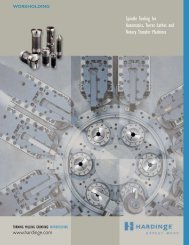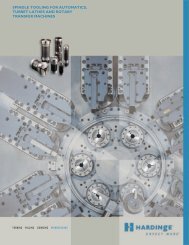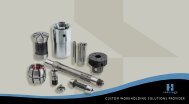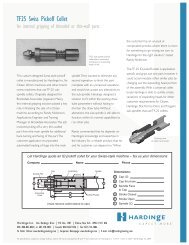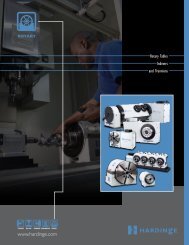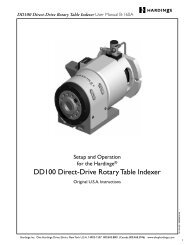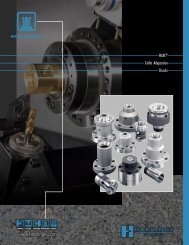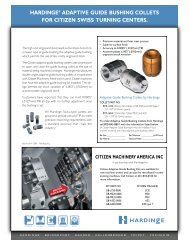Create successful ePaper yourself
Turn your PDF publications into a flip-book with our unique Google optimized e-Paper software.
Frequently Asked Questions<br />
?What is the operating range of a Quick-Change collet?<br />
The operating range is ± 1 ⁄64" (.393mm) for under a " diameter, and ± 1 ⁄3 "<br />
for a " diameter and over, when used on multi-spindle automatics for bar<br />
stock work. The operating range of the collets when used on CNC lathes<br />
is -1/64" (.393) to +.008" (. 0mm). Note that the best grip is with a full<br />
bearing, which is at the rated size of the collet. As the stock gets larger,<br />
the collet will grip at the edges of the slots; as the stock gets smaller, gripping<br />
will be at the center of the gripping surface.<br />
We continually have breakage of closing fingers and pins.<br />
Will this continue with Quick-Change?<br />
Considerably less breakage is what our customers tell us when the HQC<br />
System is used on automatic screw machines. This is a result of being able<br />
to use less force to hold the bar. Because there is no shank on the collet,<br />
less draw bar force is required for the same gripping force. Because the<br />
collet can handle a wide chucking range, you won’t have to change collets<br />
when the stock varies or risk overtightening of your closing mechanism.<br />
i machine a lot of short parts. Are there problems short chucking with Quick-Change collets?<br />
Yes & No. When gripping parts that are longer than 1 ⁄ the length of the bearing of the collet, you should have no problems. You may<br />
experience problems when your parts are shorter. Because the collet does not have a shank, it will have a tendency to collapse in the<br />
back when there is no stock to grip on. Gripping a part that is only 1 ⁄4" long will be very difficult. You can help the situation by making a<br />
stop with a diameter the same as the low tolerance on the chucking diameter of the part. With a chucking diameter of .500" that has a<br />
tolerance of -.005", the work stop bore should be .495" to .4945". This will help stop the collet from collapsing in the back.<br />
What happens when the seal holding the pads together breaks?<br />
You quickly replace the seal and the plug that holds it in. With other brands of Quick-Change systems, the entire head has to be sent<br />
back to be re-vulcanized. This requires an inventory of extra collets to make certain your production is not interrupted. We are told that<br />
most shops that use the vulcanized style system purchase a minimum of ten collet heads for their eight spindle automatics to reduce the<br />
downtime. This additional expense is not required with the Hardinge HQC System. The only item required is an extra set of seals and<br />
about five minutes of time. If your shop requires collet heads for ten different stock sizes, the cost for extra vulcanized collets will be in<br />
the thousands of dollars. The cost for an extra set of Hardinge HQC seals is around ten dollars.<br />
how often do i need to remove the Quick-Change System and clean the spindle?<br />
Use the same schedule recommended by your machine tool builder. The seals on the HQC Quick-Change Collet System create a<br />
better seal than master collets, helping to keep chips and sludge away from the back of the collet. You must still clean your spindle on a<br />
regular basis or you will eventually have problems.<br />
Should i buy a manual wrench or do i need a hydraulic wrench?<br />
A hydraulic wrench and power unit is required on a multi-spindle automatic. The work area is too confined and the reach too long for<br />
you to comfortably and quickly change the collets. For CNC lathes, a manual wrench with a standard 3 ⁄8" ratchet wrench works great. If<br />
you want to increase your speed, a hydraulic wrench will do it.<br />
i have a CnC lathe and the bar stock seems to be running on the plus side of the nominal stock size.<br />
Can i get the collet to open up a little more to handle that diameter variation?<br />
Yes. You can adjust the collet to open approximately .008" more. During setup procedure, the collet body or the draw tube adapter<br />
was set with a .030" clearance between the front of the body, or adapter, to the back face of the spindle mount. This amount can be<br />
decreased to .005", which will allow the collet to open approximately .008" more.<br />
i’ve experienced breakage problems with other Quick-Change collet systems? how will the hQC<br />
10<br />
® system hold up?<br />
The Hardinge HQC design incorporates much thicker wall sections in the highly stressed areas of the collet head and body, and has much<br />
more contact area between the head and body than other quick change systems. These features provide much less chance of breakage,<br />
maintaining productivity and eliminating costs associated with replacements, damage from crashes and downtime.



